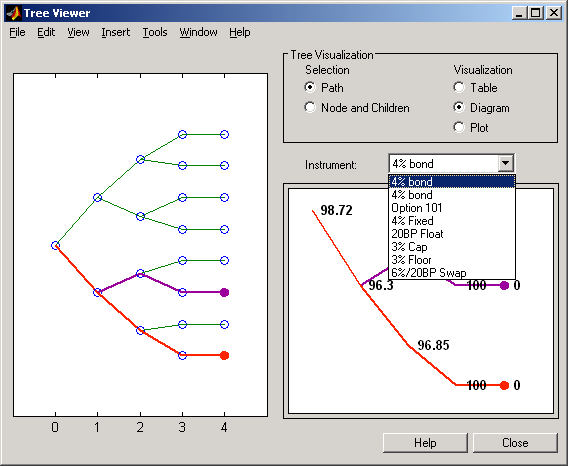Graphical Representation of Trees
Introduction
You can use the function treeviewer to display a graphical representation
of a tree, allowing you to examine interactively the prices and rates
on the nodes of the tree until maturity. To get started with this
process, first load the data file deriv.mat included
in this toolbox.
load deriv.mat
Note
treeviewer price tree diagrams follow the
convention that increasing prices appear on the upper branch of a
tree and, consequently, decreasing prices appear on the lower branch.
Conversely, for interest rate displays, decreasing interest
rates appear on the upper branch (prices are rising) and increasing interest
rates on the lower branch (prices are falling).
For information on the use of treeviewer to
observe interest rate movement, see Observing Interest Rates. For information
on using treeviewer to observe
the movement of prices, see Observing Instrument Prices.
Observing Interest Rates
If you provide the name of an interest rate tree to the treeviewer function, it displays a graphical
view of the path of interest rates. For example, here is the treeviewer representation of all the
rates along both the up and down branches of HJMTree.
treeviewer(HJMTree)

The example in Isolating a Specific Node used bushpath to
find the path of forward rates along an HJM tree by taking the first
branch up and then two branches down the rate tree.
FRates = bushpath(HJMTree.FwdTree, [1 2 2])
FRates =
1.0356
1.0364
1.0526
1.0674
With the treeviewer function
you can display the identical information by clicking along the same
sequence of nodes, as shown next.

Next is a treeviewer representation
of interest rates along several branches of BDTTree.
treeviewer(BDTTree)

Note
When using treeviewer with
recombining trees, such as BDT, BK, and HW, you must click each node
in succession from the beginning to the end. Because these trees can
recombine, treeviewer is unable
to complete the path automatically.
The example in Isolating a Specific Node used treepath to
find the path of interest rates taking the first branch up and then
two branches down the rate tree.
FRates = treepath(BDTTree.FwdTree, [1 2 2])
FRates =
1.1000
1.0979
1.1377
1.1606
You can display the identical information by clicking along the same sequence of nodes, as shown next.

Observing Instrument Prices
To use treeviewer to
display a tree of instrument prices, provide the name of an instrument
set along with the name of a price tree in your call to treeviewer, for example:
load deriv.mat
[Price, PriceTree] = hjmprice(HJMTree, HJMInstSet);
treeviewer(PriceTree, HJMInstSet)
With treeviewer you
select each instrument individually in the instrument
portfolio for display.

You can use an analogous process to view instrument prices based
on the BDT interest rate tree included in deriv.mat.
load deriv.mat
[BDTPrice, BDTPriceTree] = bdtprice(BDTTree, BDTInstSet);
treeviewer(BDTPriceTree, BDTInstSet)

Valuation Date Prices
You can use treeviewer instrument-by-instrument
to observe instrument prices through time. For the first 4% bond in
the HJM instrument portfolio, treeviewer indicates
a valuation date price of 98.72, the same value obtained by accessing
the PriceTree structure directly.

As a further example, look at the sixth instrument in the price
vector, the 3% cap. At the valuation date, its value obtained directly
from the structure is 6.2831. Use treeviewer on
this instrument to confirm this price.

Additional Observation Times
The second node represents the first-rate observation time, tObs
= 1. This node displays two states, one representing the
branch going up and the other one representing the branch going down.
Examine the prices of the node corresponding to the up branch.
PriceTree.PBush{2}(:,:,1)ans =
100.1563
99.7309
0.1007
100.1563
100.3782
3.2594
0.1007
3.5597
As before, you can use treeviewer,
this time to examine the price for the 4% bond on the up branch. treeviewer displays a price of 100.2
for the first node of the up branch, as expected.

Now examine the corresponding down branch.
PriceTree.PBush{2}(:,:,2)ans =
96.3041
94.1986
0
96.3041
100.3671
8.6342
0
-0.3923
Use treeviewer once again,
now to observe the price of the 4% bond on the down branch. The displayed
price of 96.3 conforms to the price obtained from direct access of
the PriceTree structure. You may continue this
process as far along the price tree as you want.

See Also
bdtprice | bdtsens | bdttimespec | bdttree | bdtvolspec | bkprice | bksens | bktimespec | bktree | bkvolspec | bondbybdt | bondbybk | bondbyhjm | bondbyhw | bondbyzero | capbybdt | capbybk | capbyblk | capbyhjm | capbyhw | cfbybdt | cfbybk | cfbyhjm | cfbyhw | cfbyzero | fixedbybdt | fixedbybk | fixedbyhjm | fixedbyhw | fixedbyzero | floatbybdt | floatbybk | floatbyhjm | floatbyhw | floatbyzero | floatdiscmargin | floatmargin | floorbybdt | floorbybk | floorbyblk | floorbyhjm | floorbyhw | hjmprice | hjmsens | hjmtimespec | hjmtree | hjmvolspec | hwcalbycap | hwcalbyfloor | hwprice | hwsens | hwtimespec | hwtree | hwvolspec | instbond | instcap | instcf | instfixed | instfloat | instfloor | instoptbnd | instoptembnd | instoptemfloat | instoptfloat | instrangefloat | instswap | instswaption | intenvprice | intenvsens | intenvset | mmktbybdt | mmktbyhjm | oasbybdt | oasbybk | oasbyhjm | oasbyhw | optbndbybdt | optbndbybk | optbndbyhjm | optbndbyhw | optembndbybdt | optembndbybk | optembndbyhjm | optembndbyhw | optemfloatbybdt | optemfloatbybk | optemfloatbyhjm | optemfloatbyhw | optfloatbybdt | optfloatbybk | optfloatbyhjm | optfloatbyhw | rangefloatbybdt | rangefloatbybk | rangefloatbyhjm | rangefloatbyhw | swapbybdt | swapbybk | swapbyhjm | swapbyhw | swapbyzero | swaptionbybdt | swaptionbybk | swaptionbyblk | swaptionbyhjm | swaptionbyhw
Related Examples
- Overview of Interest-Rate Tree Models
- Pricing Using Interest-Rate Term Structure
- Pricing Using Interest-Rate Tree Models
- Understanding Interest-Rate Tree Models
- Understanding the Interest-Rate Term Structure